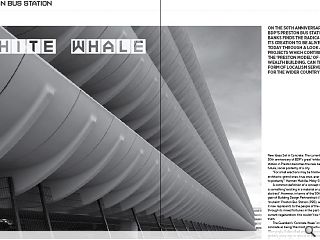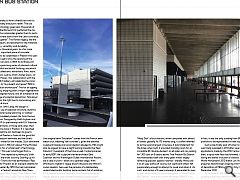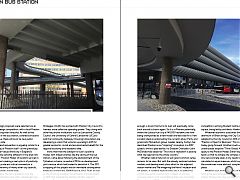Preston Bus Station: Whte Whale
23 Apr 2019
On the 50th anniversary of BDP’s Preston Bus Station Ian Banks finds the radicalism of its creation to be alive and well today through a look at the key projects which contribute to the ‘Preston model’ of community wealth building. Can this new form of localism serve as a model for the wider country?
New Ideas Set in Concrete: The current remodelling and 50th anniversary of BDP’s great ‘white whale’ of a bus station in Preston becomes the new benchmark for the future, social posterity of a city.
“For small erections may be finished by their first architects; grand ones, true ones, ever leave the copestone to posterity”: Herman Melville, Moby-Dick
A common definition of a concept being ‘concrete’ is something ‘existing in a material or physical form; not abstract’. However, in terms of the 50th anniversary this year of Building Design Partnership’s (BDP) so-called ‘brutalist’ Preston Bus Station (PBS), and in terms of what it now represents to the people of the city symbolically through its mixed fortunes in the past and during its current regeneration, this couldn’t be further from the truth.
The Guardian’s ‘Concrete Week’ in February described concrete as being ‘the most destructive material on earth’. Worryingly, it described enough concrete being poured globally every day to rebuild an equivalent of the Three Gorges Dam in China. Concrete is now the Earths most used material after water - and the third largest CO2 emitter. Despite such environmental concerns, concrete is an essential commodity to form a literal bed-rock to reinforce our civic society and public realm. The use of proto-concrete technology goes back thousands of years, during which the Romans first perfected the mix to make the sum of the composites greater than its parts. Indeed, the word concrete stems from the Latin concretus, meaning “to grow together”. The Roman legacy, like the Pantheon and Colosseum, are testament to the materials propensity for beauty, versatility and durability.
Roll on nearly two thousand years, to a far more modest but still very important piece of concrete ‘archaeology’ about to be celebrated in Preston this year: October will mark 50 years since the opening of the city’s iconic PBS and car park in 1969. Its birthday will act as the focus for a year-long series of planned cultural events for this ‘beautiful and brutal’ building, and which will include curated collections, exhibitions, films, tours and artist interventions. Led by artist Charles Quick, co-curator of In Certain Places , this collaboration with the Harris Museum and Art Gallery will celebrate the iconic modernism and look to “re-present and reveal” PBS to “contextualise the social architecture”. This for an ageing building now currently enjoying both a major regeneration and a creatively reimagined future, and all achieved at the 11th hour, on the verge of potential demolition. Talk about waiting a long time for the right bus to come along and then several turn up at once.
Built by contractor John Laing, the design is characterized by the use of exposed structure, dynamic geometry and functional space-planning. A ‘scallop-shell façade of GRP moulded precast ribs form the bus station’s signature look. Designed by Keith Ingham and Charles Wilson of BDP (in partnership with E.H Stazicker and Ove Arup and Partners), in those early days, their offices included a home base in Preston. It is reported that Ingham had stated the aim had been to give to the ordinary people of Preston a ‘taste of the good life’ through allusions to airport terminals and the (then) deemed luxury of air travel for the masses. Such sentiment mirrored the utopianism in 1963 of Labour Prime Minister Harold Wilson’s vision for a “white heat” of technology era for “New Britain”. This was to be forged from a “scientific revolution” that replaced a previously ‘cloth cap’ provincialism of the wider country. Gearing up for this growth, the New Towns Act had earmarked a ‘Red Rose Development’ for Preston as an overspill satellite for Liverpool and Manchester. By 1970 this had culminated in the designation of a Central Lancashire New Town, the largest of the English New Towns. Thus Preston had been set up to become a new ‘Super City’ to deal with a population explosion that just never came. But at least it had a bus station ready, and with future capacity to spare.
Often referred to as being built in the brutalist style (the original term “brutalism” comes from the French term betón brut, meaning ‘raw concrete’), given the detailed sculptural façade and social idealism alluded to, PBS might also be argued to have a slight leaning towards the ‘Neo-Futurism’ movement of the time as well. Contemporaries to early BDP, like sculpture-trained architect Eero Saarinen and his Washington Dulles International Airport, are a case in point – albeit on a grander stage. With affinities to Ingham’s vague airport allusions and Wilson’s social idealism, here was the paradox of a deliberately understated public building being similarly full of ambition for a positive future of aesthetic functionality, linked to rapidly growing cities and technological advancement.
Regardless of whatever taxonomic rank of architecture is agreed for the bus station, size-wise at least, after 50 years this iconic monolith still remains the indisputable ‘Moby Dick’ of bus stations, when compared with almost all others globally. At 170 metres long, it is often referred to as the second largest in Europe. A bold statement for the times when built, it provided standing room for an incredible 80 ‘double-deckers’ on all sides and car parking for 1,100 cars on 9 decks above. That Preston Bis Station has maintained itself over many years whilst largely remaining popular, speaks volumes - literally. Many saw it as an ugly edifice of course, but significant others felt passionately enough to attempt to covet and retain it. As such, and during a 13-year campaign it generated its own appreciation society and pressure group to ‘Save Preston Bus Station’ - and even a short film titled ‘56000’ in its homage. It also ranked in an incredible second position in BDP’s own generated public poll and ‘Placebook’ created to mark the practices own 50th anniversary year in 2011. In fact, it was the only building from BDP’s 20th century portfolio to be represented in their top ten at all.
Such pride finally paid off when Grade II listed status was finally awarded in 2013 after several spot listing applications made by the 20th Century Society. Since then, a rapid volte-face has followed, driven by the listing and earlier inclusion of classed ‘at-risk’ on the World Monuments 2012 Watch List. Not before time, as enquiries had still been ongoing into the real possibility of demolition of PBS by Preston City Council as late as December 2012.
To facilitate its full reprieve from death row, the building ownership was first transferred to Lancashire County Council (LCC) in 2014 for a peppercorn sum. As a result, the current £25m design for a remodelled complex and surround is now being led by architects John Puttick Associates. Their design proposals were selected via an RIBA international design competition, with a local Preston poll of citizens selecting their favourite. As well as the critical regeneration of the bus station, covered concourse and car parking above, there will soon be new public square added to one side.
This late escape and reinvention is arguably similar to a fall and rise of the city of Preston itself - as the previously overlooked and under-valued third city in England’s North West. Things are certainly different in the area now however, with a new ‘Preston Model’ of localism set well in motion and this reboot creating a real upturn of positivity. Such enhanced civic pride and critical momentum is also fast becoming the envy of many other city councils, politicians and economists world-wide.
The Preston Model is the term applied to how the council, its anchor institutions and other stakeholders are now implementing the principles of ‘Community Wealth Building’ in both city and neighbouring Lancashire. The UK independent think tank The Centre for Local Economic Strategies (CLES) has worked with Preston City Council to harness more collective spending power. They, along with other key anchor institutions such as Lancashire County Council, the University of Central Lancashire (UCLan) and the Community Gateway (Housing) Association are developing a vision that unlocks a paradigm shift for greater economic, social and environmental benefit for the regional economy and residents alike.
Ironic then that the catalyst for such a positive model, with linked schemes like the saving of the bus station, came about following the abandonment of the Tythebarn scheme, an earlier £700m re-development joint venture which had looked to demolish it. The 2011 scrapping of this project was an inevitable consequence following on from the 2008 financial crisis. That, as well as the incoming Coalition Governments announcement in 2010 that initiated the abolition of New Labour’s Regional Development Agencies and dismantling of the regeneration gravy train they helped drive.
But like the cyclical global economy, if you wait long enough, a boom that turns to bust will eventually come back around to boom again. So it is in Preston potentially, where the Labour-run city of 140,000 residents are now being championed as a new model and test bed for a ‘new socialist ideal as endorsed by the current Labour Party and grassroots Momentum group. Leader Jeremy Corbyn has described Preston as an “inspiring” innovation in a 2017 speech, whilst a year earlier, his Shadow Chancellor John McDonald had observed “This kind of radicalism is exactly what we need across the whole country”.
Whether radical futurism or just good common sense remains to be seen. But with the already restored outdoor markets and development plans afoot for the adjacent indoor market and ‘Re-imagining the Harris’ museum and art gallery, it certainly feels like the city is re-gathering critical pace across many fronts. Indeed, UCLan are now also well on with consolidating their own University Masterplan and 2020 vision. This integrates the city campus far more seamlessly into the fabric of Preston, and includes at its heart, a £57m design scheme for an competition-winning Student Centre and major new public square, being led by architects Hawkins\Brown.
Whatever economic outcomes the next cyclic downturn or Brexit brings, the City Centre Action Plan adopted by the City Council in 2016 states as its USP that ‘Preston is Open for Business’. This is certainly self-evident today going forward. Another much-used but often unattributed strapline “Think Global, Act Local” might also apply to the Preston Model. Either way, Preston can help teach us that to achieve the complex alchemy of setting any new concrete ideal, a city needs to be visionary yet calculated in equal measure, whilst supporting at the core the sometimes more abstract complexities of people and place.
Whether seen as the third city of the North West or having the second largest bus station in Europe, doesn’t matter. Preston has now put itself in first place again looking towards a future where the democratic case for a new economic ideology and cultural mojo is back at the front of a queue, and where everyone is invited on board.
|
|





